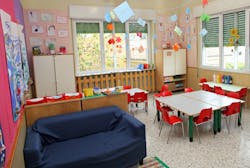As schools and universities continue to cope with the Covid-19 pandemic and work to provide safe and healthful learning spaces, the benefits of incorporating flexibility into classroom layout have been receiving more attention.
But even before the effects of Covid-19 disrupted educational facilities, many school planners have been advocating for some time for more flexibility in how learning spaces are designed and how the furniture and equipment in them is chosen. Many classrooms have been outfitted with moveable tables and chairs and other seating options that accommodate the different learning styles and comfort levels of students.
Educators like to have research and data to back up the decisions they make. A recent study provides evidence to support the belief that flexible classroom furniture benefits students. The research found that students assigned to classrooms with flexible furniture displayed more positive feelings about the classroom and their schooling compared with those assigned to classrooms with more traditional furniture.
“The study provides supportive data that flexible furniture in the learning environment has the potential to create learning environments that can influence students' perception of their classroom and ultimately their feelings toward school,” says the study, “Investigating the Impact of Flexible Furniture.”
The study was conducted by Learning Experience Research, a partnership of Baylor University, Education Service Center 12 in central Texas, and the Huckabee architecture firm. The researchers said most of the studies on flexible furniture enhancing learning environments has been done at the university level, so they focused their study on elementary classrooms.
“With more schools beginning to redesign their learning environments through implementation of flexible furniture, it is important to focus on the influence this furniture has on the students within the learning environment,” the study said.
The researchers looked at 10 third- and fourth-grade classrooms, some of which were outfitted with traditional furniture and some with flexible furniture. Traditional furniture was defined as stationary desks and chairs, and flexible furniture was defined as work surfaces and seating that “provide and support students’ choice of seating, location, comfort and classroom peer interaction.”
Flexible furniture provided a variety of seat choices, including more seats open than being used, a variety of heights in seating options, and various types of seating (soft, active, standard). Work surfaces in flexible classrooms included a variety of height-adjustable tables, flip tables and writable tables or surfaces.
Students reported preferring the classrooms with flexible furniture.
“Students in classrooms equipped with flexible furniture perceived their classroom as more comfortable than did students in classes that maintained the traditional furniture provided by the school district,” the study found.
Those students also reported a greater feeling of autonomy when they were provided flexible furniture.
“The results suggest that when classrooms are equipped with flexible furniture, teachers allow students to explicitly choose their work surface independently throughout the class day based on the activity they are participating in and comfort level.”
The availability of flexible furniture can enhance the relationship between students and teachers, the study suggested.
“The present study’s findings along with others suggest that having an architectural design that facilitates movement and choice through flexible furniture can begin to blur the line between instructor and students, creating an environment that creates authentic community among students and teachers,” the study said.
The study also noted that to optimize the effect furniture has on the learning environment and student engagement, teachers should be given professional development.
The professional development offered to teachers in the study encouraged them “to examine and reevaluate classroom management techniques that would allow students the freedom to move and utilize the flexible furniture to build student autonomy and promote activity.”
“Future research is needed to better understand the connection between teacher professional development and flexible learning environments,” the study said.
The authors of the study say they hope their research will help persuade school districts to embrace flexible classroom furniture as an effective way of enhancing the learning environment for students.
“School administrators, who are responsible for allocating funds for new facilities and redesigning current facilities might use this data to advocate for modern learning environments equipped with flexible furniture,” the study said. “Finally, this study provides information that can be utilized to guide policymakers’ decisions regarding classroom design and equipment.”
About the Author
Mike Kennedy
Senior Editor
Mike Kennedy, senior editor, has written for AS&U on a wide range of educational issues since 1999.
